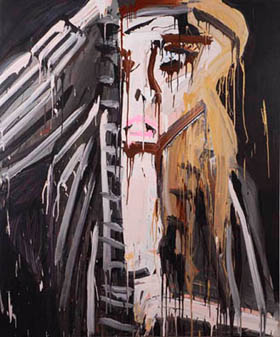5.2.25 — Uncertainty and Silence
To wrap up from last time on the future of HaberArts, themes are nice, and I still believe that art takes words. Yet I think differently now, in smaller bites that reach out to readers. If I had years of accumulated ideas to get through, fine, so long as they inform the art.
 The art scene has changed, too, and I have changed along with it. Where “theory” once felt dominant, it has left mostly glib vocabulary and good intentions. It has also left me to discover yet again what I have to say. So how have my first instincts held up, and what has not?
The art scene has changed, too, and I have changed along with it. Where “theory” once felt dominant, it has left mostly glib vocabulary and good intentions. It has also left me to discover yet again what I have to say. So how have my first instincts held up, and what has not?
Naturally I gravitated toward the Minimalism and formalism of my classmates—and of such icons as Carl Andre and Richard Serra who can extend art to the felt experience of the gallery. So, for that matter, have younger artists, and their concerns have made a recovery, with what I have called Neo-Minimalism. The Post-Minimalism of Eva Hesse and Senga Nengudi lives on in others today as well. More generally, I cannot set aside my love of abstract painting. In the years when, all the right people said, painting was dead, I found my way to Snug Harbor in Staten Island for reassurance that it was very much alive. And I still debate with myself what could make it powerful and new.
Abstraction is no longer all that abstract. It had bred a hybrid of realism, patterns, and myth, often centered on images of a woman’s body. And I can fairly claim to have been ahead of the curve, with early reports on several artists still hard to pin down, like Amy Sillman, Katherine Bernhardt, and Cecily Brown. At the same time, I have had to question the trend. When “anything goes,” what still matters? I keep questioning the commercial instincts of museums as well.
I had my shot at Postmodernism, but I could not give up my love of early Modernism, Abstract Expressionism, or late modern art (not to mention the Renaissance). I argued back then for a “postmodern paradox“: the call to dismiss Modernism made art dependent on it and kept it alive. And, sure enough, Modernism has spawned an impressive art fair, the Independent Modern. Meanwhile my own tastes have broadened, increasingly to public sculpture, architecture, and photography. Who knows what “public” and “private” mean anyway when you enter a museum.
Theory has itself moved on, becoming less a critique than a yearning for diversity. I have, I hope, taken special care to cover black artists like Bob Thompson, Isaac Julien, Kara Walker, black abstraction, and ever so much more—going back to when the Museum of Modern Art posed a choice of exhibitions in adjacent rooms for Jacob Lawrence and Wassily Kandinsky. I have aimed for a still greater advocacy of women artists, a theme of this Web site from the start. And in fact the single largest change in art over the years has been the rediscovery of past women artists and present-day Latin and Native Americans alongside white men. Yet I have my doubts about the tone of relentless celebration. Whatever happened to irony, urgency, and anger?
So where does that leave me? Stuck indoors with my leg raised and my expectations diminished. If I was ever breaking ground, and I have my doubts, I no longer am. Can I can look forward to writing again, but less often? It could make an exhibition less of a compulsion and more of a pleasure. For now, expect uncertainty and silence.
Read more, now in a feature-length article on this site.